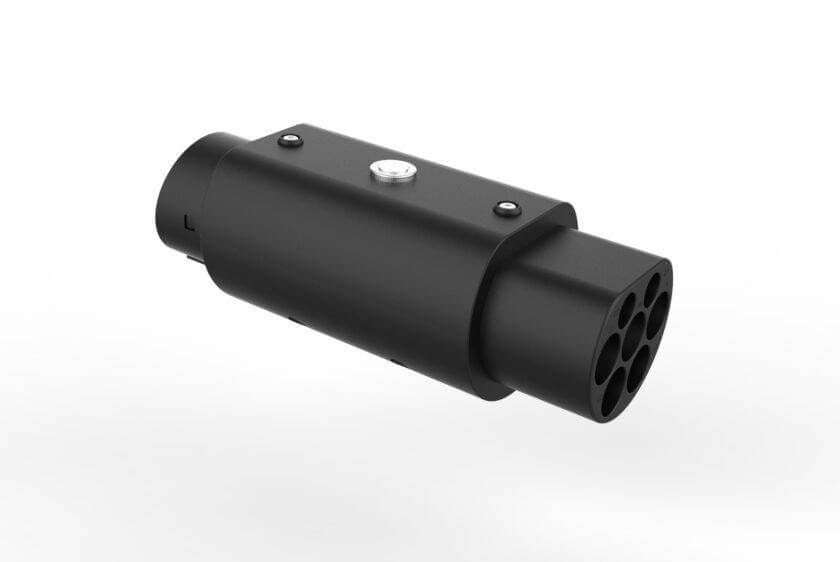Electric vehicles (EVs) are becoming increasingly popular, but charging compatibility remains a challenge for many owners.
If your EV has a Type 1 (J1772) connector but most public charging stations use Type 2 (Mennekes), you’ll need a Type 2 to Type 1 EV adapter.
This comprehensive guide covers everything you need to know about these adapters, including:
- Key differences between Type 1 and Type 2 connectors
- Safety considerations
- Best adapters in 2025
- Common mistakes to avoid
- Pricing and setup
Let’s dive in!
Understanding Type 1 and Type 2 EV Connectors
What is a Type 1 Connector?
- 5-pin design (2 AC power, 1 ground, 2 communication pins)
- Common in North America, Japan, and older EVs
- Also known as SAE J1772
What is a Type 2 Connector?
- 7-pin design (supports 3-phase AC charging)
- Standard in Europe, Australia, and newer EVs
- Also called a Mennekes connector
Key Differences
| Feature | Type 1 (J1772) | Type 2 (Mennekes) |
|---|---|---|
| Pins | 5 | 7 |
| Region | North America, Japan | Europe, Australia |
| Charging Speed | Up to 7.4 kW | Up to 22 kW (3-phase) |
| Locking Mechanism | Manual | Automatic |
Can You Charge a Type 1 Car with a Type 2 Charger?
✅ Yes, with a Type 2 to Type 1 adapter.
- The adapter bridges the connection between a Type 2 charging station and a Type 1 EV port.
- Ensure the adapter supports your car’s charging speed (e.g., 7.4 kW for most Type 1 EVs).
⚠️ Note: Some manufacturers (like Tesla) may require specific adapters.
What is the difference between Type 1 and Type 2 Adapters?
- Type 1 to Type 2 Adapter: Lets a Type 1 car use a Type 2 charger.
- Type 2 to Type 1 Adapter: Lets a Type 2 charger connect to a Type 1 car.
Most adapters are unidirectional, so choose the right one for your needs.
Is Tesla Type 1 or Type 2?
- Tesla in North America: Uses a modified Type 1 (Tesla Proprietary Connector).
- Tesla in Europe/Australia: Uses Type 2.
- Solution: Tesla owners may need a Type 2 to Tesla adapter or a Type 1 adapter depending on region.
What is a Type 2 to Type 2 EV Charging Cable?
- Used for Type 2 to Type 2 connections (e.g., home charging stations).
- Not needed if your car and charger both have Type 2 ports.
Why You Need a Type 2 to Type 1 EV Adapter
🔹 Compatibility: Charge at any public station.
🔹 Cost-Effective: Cheaper than modifying your car’s charging port.
🔹 Travel-Friendly: Essential for EV owners traveling between regions.
Best Type 2 to Type 1 EV Adapters in 2025
- Lectron Type 2 to J1772 Adapter (Best Overall)
- Tesla Type 2 to Type 1 Adapter (For Tesla Owners)
- JuiceBooster Omni Charger (Premium Option)
- EVSE Adaptors Pro (High Durability)
- Zencar Type 2 to Type 1 (Budget Pick)
Type 2 to J1772 Adapter: What You Need to Know
- J1772 = Type 1 in North America.
- Ensure the adapter is UL-certified for safety.
J1772 Type 1 vs. Type 2: Key Differences
| Feature | J1772 (Type 1) | Type 2 |
|---|---|---|
| Max Power | 7.4 kW | 22 kW (3-phase) |
| Common Use | Older EVs, North America | New EVs, Europe |
Is a Type 1 to Type 2 Adapter Safe?
✅ Yes, if:
- It’s from a reputable brand.
- It has overcurrent/overvoltage protection.
- You inspect it before each use.
❌ No, if:
- The adapter is damaged.
- Your car manufacturer prohibits adapters.
Can You Install a Type 2 Connector at Home?
✅ Yes!
- Requires a Type 2 wallbox charger.
- Future-proofs your home for newer EVs.
Type 2 Female to Type 1 Male Adapter: How It Works
- Female Type 2 (fits onto charger).
- Male Type 1 (plugs into car).
5 Common Mistakes to Avoid When Using an EV Adapter
- Using an incompatible adapter
- Ignoring damage signs (frayed cables, burns)
- Overloading the adapter (exceeding power limits)
- Leaving the adapter plugged in when not in use
- Buying cheap, uncertified adapters
How to Choose the Right Type 2 to Type 1 Adapter
✔ Check compatibility with your EV.
✔ Look for safety certifications (CE, UL).
✔ Consider charging speed (7.4 kW vs. 22 kW).
✔ Read customer reviews.
Setting Up Your Type 2 to Type 1 EV Adapter
- Park your EV safely.
- Plug Type 2 end into the charger.
- Connect Type 1 end to your car.
- Start charging.
- Disconnect properly after use.
Type 2 to Type 1 EV Adapter Price Guide (2025)
| Brand | Price Range | Best For |
|---|---|---|
| Lectron | 80−120 | General Use |
| Tesla Adapter | 150−200 | Tesla Owners |
| Zencar | 50−80 | Budget Option |
Conclusion
A Type 2 to Type 1 EV adapter is a must-have for EV owners needing cross-compatibility. Whether you’re traveling or using public chargers, the right adapter ensures seamless charging.
🚗 Need a reliable Type 2 to Type 1 EV adapter?
👉 Contact Us Today for expert recommendations!





